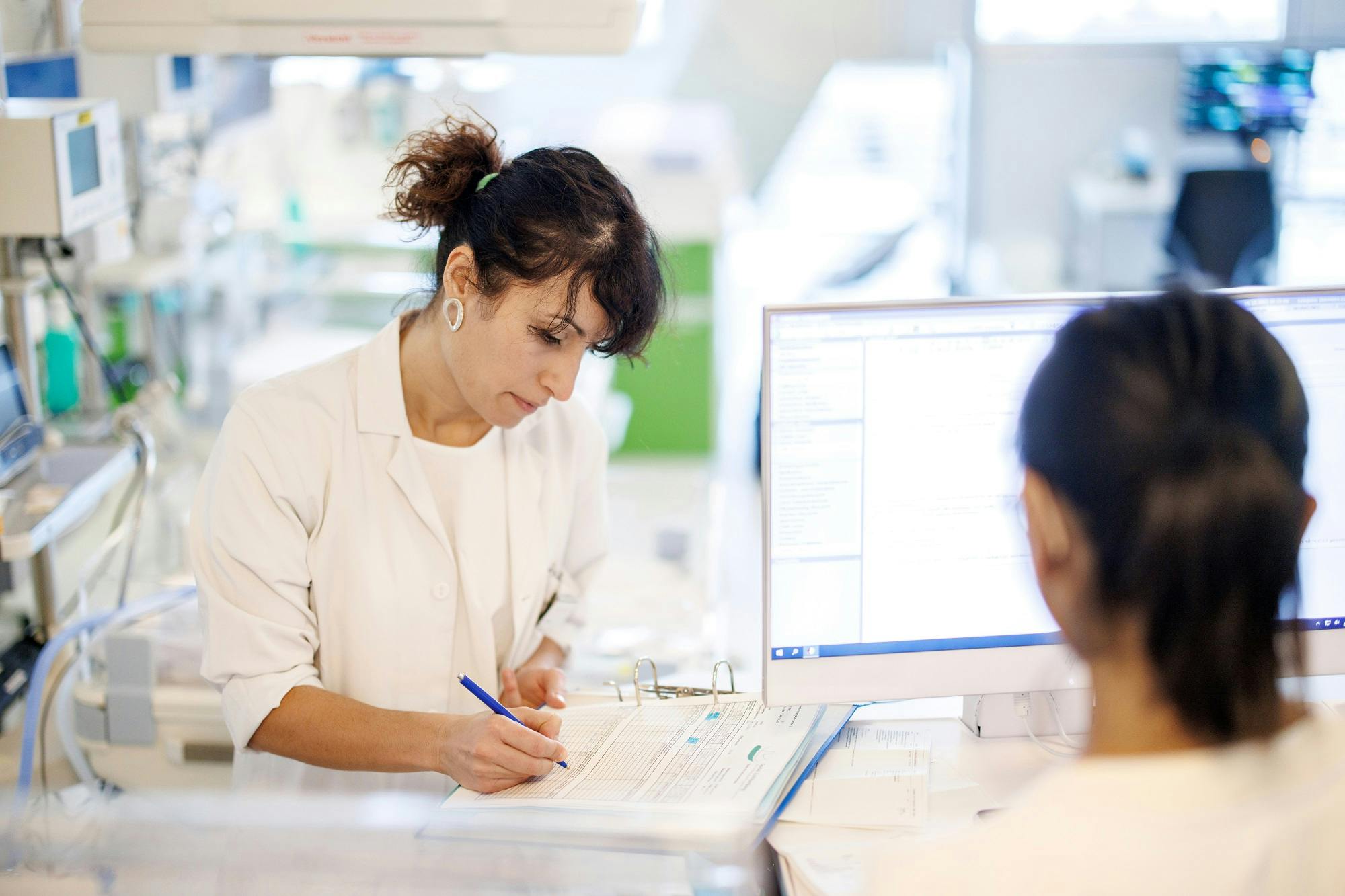Radiological diagnosis of osteoporosis: Everything you need to know - an interview with Dr Stephan A. Meier, Head of Radiology at Zollikerberg Hospital
Dr. med. Stephan A. Meier
July 16, 2025
10 min
Osteoporosis often goes unnoticed for a long time - radiology plays a crucial role in early detection. In this interview, Dr Stephan A. Meier, Head of Radiology, explains which procedures are used, who is particularly at risk and what patients should look out for.
What role does radiology play in the diagnosis of osteoporosis - and when should an examination be considered?
Radiology plays a central role in the diagnosis and assessment of osteoporosis. Imaging techniques visualise bone density and fractures and thus provide crucial information for early detection, diagnosis, fracture analysis and follow-up. The DXA measurement is the most important procedure for primary diagnosis. According to guidelines and professional associations (e.g. DVO, the umbrella organisation for osteology), an examination is recommended for women aged 70 and over and men aged 80 and over - provided there are no risk factors.
Which imaging procedures are used to measure bone density and how do they differ? What is special about it at Zollikerberg Hospital?
Various imaging procedures are used for bone density measurement (osteodensitometry). The most important are
1. DXA or DEXA (dual X-ray absorptiometry)
This is an X-ray procedure in which the body is scanned with two different doses of X-rays that are weak overall. The measurement is mainly carried out on the lumbar spine and hips.
Advantages:
- Very precise and standardised
- Low radiation exposure
- Gold standard in osteoporosis diagnostics
Disadvantages:
- Limited informative value in the case of severe obesity or scoliosis
2 QCT (quantitative computer tomography)
This involves a computerised tomography scan for three-dimensional bone density measurement - primarily on the spine, less frequently on the hip.
Advantages:
- Separate recording of trabecular (internal) and cortical bone substance
- More suitable for degenerative changes
Disadvantages:
- Higher radiation exposure than with DXA
- More expensive and less widespread
3. pQCT (peripheral quantitative computed tomography)
This is a CT-based measurement of peripheral sections of the skeleton such as the forearm or tibia. It is currently mainly used in research or for specific issues.
Advantages:
- Measures density, geometry and strength
- Lower radiation exposure than conventional CT
Disadvantages:
- Limited availability
- Not standardised for routine clinical diagnostics
4 QUS (quantitative ultrasound)
Bone density is measured here using sound waves on the heel bone or finger.
Advantages:
- No radiation exposure
- Mobile and inexpensive
Disadvantages:
- Less accurate
- Not authorised for diagnostics according to WHO criteria
DEXA is currently regarded as a standard procedure with high accuracy and good comparability. At Zollikerberg Hospital, we use state-of-the-art DXA technology in combination with structured image analysis and interdisciplinary reporting. Close collaboration with the endocrinology department enables a well-founded risk assessment and individualised treatment planning - all under one roof.
How reliable is the DEXA measurement (Dual Energy X-ray Absorptiometry) in assessing fracture risk?
DEXA measurement (Dual Energy X-ray Absorptiometry) is currently the gold standard for determining bone density and is considered to be very reliable in assessing fracture risk. Other procedures often base their assessment on the results of DEXA.
The so-called T-score is determined, which compares the measured bone density with that of a young, healthy reference population. The T-score correlates well with the fracture risk and, if carried out correctly, has very good reproducibility and comparability. The World Health Organisation (WHO) uses the DEXA measurement as a basis for diagnosing osteoporosis.
One limitation of the method is that DEXA only measures bone density - not bone quality (e.g. microarchitecture), the individual risk of falling, muscle function or balance. Accompanying diseases such as osteoarthritis can also falsify the measurement results and lead to an apparently higher bone density. Bone density is usually measured at the lumbar spine, hip and wrist - other potential fracture locations are not taken into account.
In order to include these additional risk factors in the assessment, supplementary fracture risk assessment tools are used:
- FRAX® tool: This combines the measured DEXA value with clinical risk factors (e.g. age, tendency to fall, family history) to determine the probability of a future fracture risk.
- TBS (Trabecular Bone Score): The TBS is a complementary parameter that is collected together with the DEXA measurement to provide a more accurate assessment of bone quality and fracture risk. Specifically, the TBS analyses the microscopic structure of the spongy (trabecular) bone, which makes a decisive contribution to stability. The analysis is performed on the basis of DEXA data using special software. The TBS can be calculated in particular for the lumbar vertebral bodies, which are usually included in the DEXA measurement. As an additional parameter, the TBS complements the classic bone density and improves risk assessment - especially in modern osteoporosis diagnostics, where a differentiated assessment of bone quality is crucial.
Are there radiological warning signs or findings that are often overlooked but may indicate the onset of osteoporosis?
Radiological warning signs or findings that may indicate the onset or presence of osteoporosis are changes in the shape of the vertebral body, so-called wedge, fish or flat vertebrae. Discrete reductions in the height of the vertebral bodies can also be early signs. Deformed or already collapsed vertebral bodies without any known trauma indicate insufficient fractures.
There is also often an increased "show-through" of the bone, which indicates a reduced cancellous bone structure (the interior of the vertebral body).
In general, fractures without adequate trauma, for example in the ribs, pelvis or upper arm, after trivial falls or even without recognisable trauma, are serious warning signs.
How does a typical bone density measurement work in your department - and do patients need to make any special preparations?
Bone densitometry (DEXA) is carried out in several clearly structured steps:
- Information about the procedure, the aim of the examination and the overall very low radiation exposure
- Completion of a questionnaire that provides additional information for the assessment
- The actual measurement takes place on a flat examination table of the DEXA device. A scanner moves slowly over the body region to be examined. The usual measurement locations are the lumbar spine, hips and possibly the forearm.
The examination takes about 10 to 20 minutes. - It is then analysed using software that calculates the bone density both in comparison to a young, healthy reference population and to age-appropriate standard values. The radiologist also assesses the images for fractures, structural abnormalities or possible incorrect measurements.
- The results are then discussed on an interdisciplinary basis with an endocrinology specialist so that a well-founded treatment recommendation can be made - for example, follow-up, initiation of treatment, vitamin D check.
Which groups of people should have regular tests - and are there any recommendations on the frequency of testing?
Certain risk groups should have regular DEXA measurements in order to recognise osteopenia or osteoporosis at an early stage and prevent fractures.
Recommended groups:
- Women aged 65 and over, especially postmenopausal women
- earlier if there are risk factors - Men aged 70 and over
- from the age of 50 if there is an increased risk
Younger people with risk factors:
- Fractures without adequate trauma (e.g. vertebral body, radius or femoral neck fracture)
- Family history (e.g. hip fracture in the mother)
- Early menopause (< 45 years), oestrogen deficiency
- Chronic diseases such as rheumatoid arthritis, chronic kidney disease, coeliac disease or Crohn's disease
- Long-term use of bone-damaging medication:
- Cortisone (from 3 months ≥ 5 mg prednisone daily)
- Antiepileptic drugs, aromatase inhibitors, heparin, etc. - Underweight (BMI < 20), eating disorders
- Nicotine or alcohol abuse
- Lack of exercise / immobility
Examination frequency:
- Every two years for existing osteoporosis or osteopenia
- After starting therapy: First check-up usually after two to three years
How do you think radiological diagnostics are developing in the early detection of osteoporosis - are there any new technologies or trends?
Radiological diagnostics in the early detection of osteoporosis is changing - with the aim of detecting fracture risk earlier, more precisely and more comprehensively. In addition to the classic DEXA measurement, several new technologies and trends are currently developing that are expanding the diagnostic spectrum:
Artificial intelligence (AI) in image analysis can be supportively helpful. For example, by automatically recognising vertebral fractures on X-ray, CT or MRI images. AI can recognise subtle fractures that may easily escape the human eye. AI can also be used to screen and analyse routine CT scans.
High-resolution pQCT (HR-pQCT)
New technology with extremely high resolution for visualising the microstructure of the bone (e.g. cancellous bone). These are still mainly used in research, but are very promising for the future.
Use of vertebral body deformity detection (Vertebral Fracture Assessment - VFA) in DEXA. We are already using this at Zollikerberg Hospital.
The future of osteoporosis diagnostics lies in the combination of classic procedures (DEXA) with intelligent image evaluations, AI, structural analyses and opportunistic diagnostics from existing data. This will enable earlier and more individualised risk assessment - often even without additional examinations.
Weitere Beiträge
Counsellor
Hormone fluctuations in winter: What's really behind them?
Many women experience changes in their physical and mental well-being in winter. They feel tired more often, less resilient or more emotionally sensitive. Cycle changes or more intense premenstrual symptoms are also noticed more often during this time. In addition to external factors such as the cold, less exercise or a change in lifestyle, hormonal processes can also play a role.
Counsellor
Spinal surgery: everything you need to know
At Zollikerberg Hospital, the highest precision applies to one of the most central and at the same time most demanding areas of the body - the spine. Spinal surgery here means not only modern, minimally invasive technology, but above all sound expertise, experience and careful, holistic care. This is what Dr Filippo Mandelli, Head of the Spinal Surgery Clinic, and his team stand for. They treat conditions such as herniated discs, spinal canal stenosis, spondylolisthesis, spinal deformities and degenerative changes competently and sensitively and accompany patients on their way to greater stability and quality of life. In this interview, you can find out what is particularly important in these complex interventions - and what modern spinal medicine can achieve today.
Counsellor
Eyelid lift (blepharoplasty) for drooping eyelids - a brief overview
The eyes are the mirror of our soul - and yet drooping eyelids, bags under the eyes or sagging skin on the eyelid can leave a tired and older impression. If you would like to regain an alert, fresh look, an eyelid lift (blepharoplasty) at Zurich Plastic Surgery can help. In this blog post, Prof Dr Hisham Fansa, Head of Plastic Surgery Zurich, explains why many people decide to have their drooping eyelids corrected and what is important during this procedure.


